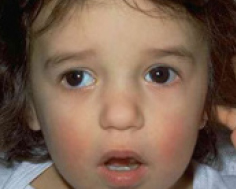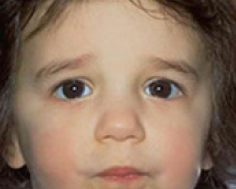Exotropia is a type of strabimus or eye misalignment. Exotropia refers to an outward deviation of the eyes. Although Exotropia commonly begins around age 2 to 4 years, it can appear at any age.
WHAT ARE THE SIGNS OF EXOTROPIA?
A noticeable outward deviation of the eyes is usually the primary sign. Initially, this form of strabismus may only be seen when your child is tired or not feeling well. Typically the deviation is noted more when the child looks in the distance and not as much when viewing close objects. Your child may be seen squinting or rubbing one of the eyes. A child with exotropia may close one eye particularly in bright sunlit environments. Few children will complain of double vision.
MAKING THE DIAGNOSIS
The pediatric ophthalmologist will perform all of the necessary tests to confirm that your child has an exotropia. This includes a comprehensive ocular motility exam and an evaluation of the internal ocular structures achieved with eye drops that dilate the pupils.
Treatment
Eye muscle surgery to improve ocular alignment is generally recommended if one or more of the following criteria are present:
- If the exotropia is present for more than 50% of each day.
- If the frequency of the exotropia is definitely increasing over time although it is not yet apparent for 50% of each day.
- If there is a significant exotropia when your child intently views objects at near.
- If there is evidence that your child is losing “binocular vision.” This refers to the brain’s ability to use both eyes together as a single unit. Among other benefits, binocular vision affords optimal depth perception.
If none of these criteria are met, surgical intervention is generally not recommended and simple observation with or without some form of eyeglass and/or patching therapy is then warranted.
What About Eye Patches And Glasses?
It is not uncommon that children with any form of strabismus (including exotropia) will have decreased vision in one eye. This is known as “amblyopia”. If there is a significant amblyopia present, the pediatric ophthalmologist will prescribe the appropriate eye patch to be worn over the stronger eye to force your child to use and strengthen the eye with amblyopia. If your child has a need for eyeglasses, they will be prescribed as well.
The eye muscle surgery is generally not recommended until the vision in each eye is maximized with either patching therapy and/or eyeglasses when appropriate. In some children, the exotropia can improve with only these measures and an operation may become unnecessary.
What About Eye Muscle Exercises?
There is an unusual type of exotropia known as “convergence insufficiency” that responds best to eye muscle exercises. This disorder is characterized by an inability of the eyes to work in unison when the child attempts to use the eyes at near only (e.g. reading). Instead of the eyes converging together on the near object, one of the eyes deviates outward.
Aside from treating convergence insufficiency, eye muscle exercises have proved to be an ineffective form of strabismus therapy.
Will My Child Outgrow This Problem?
If the exotropia is mild and none of the four treatment criteria listed above are applicable, then there is a small chance that the exotropia will diminish with time. However, if the exotropia is significant and meets any of the four criteria listed, it is very unlikely that the exotropia will improve without surgery.
WHY IS GOOD OCULAR ALIGNMENT IMPORTANT IN CHILDHOOD?
Aside from the obvious improvement in your child’s appearance when misaligned eyes are corrected, there are other functional benefits to consider. When a significant ocular misalignment exists in childhood, the brain’s developing visual system does not acquire binocular vision. Aside from improved depth perception, a person with binocular vision tends to maintain good ocular alignment throughout life. Additionally, a child with good ocular alignment is at decreased risk for developing amblyopia.


Three-year old girl with an intermittent exotropia. The photo on the top demonstrates her exotropia. Moments later, her eyes spontaneously became well aligned as illustrated in the photo on the bottom.
Pediatric Ophthalmic Consultants
40 West 72nd Street, New York, NY 10023 | 212-981-9800
The content of this Web site is for informational purposes only. If you suspect that you or your child has any ocular problem,
please consult your pediatrician, family practitioner, or ophthalmologist to decide if a referral to a pediatric ophthalmologist is required.
































